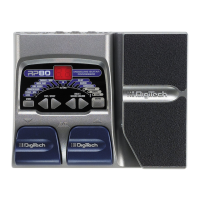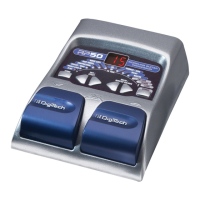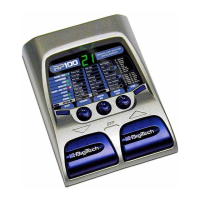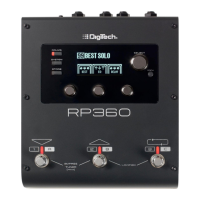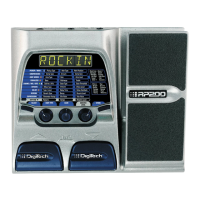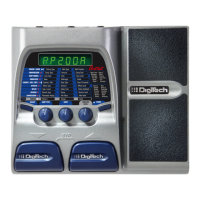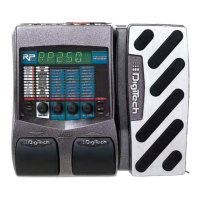Gate On/Off - The Number 1 Knob turns the Noise Gate on (On) and off (OF).
Gate Type - The Number 2 Knob selects between the Silencer ™ (
silncr ) or Pluck (pluck) type of
Noise Gates.
Gate Attack - The Number 3 Knob adjusts the length of time it takes the gate to open once the
Threshold has been exceeded before the signal becomes audible. Ranges from 1 (immedi-
ate signal), to 9 (Selects the Auto Swell volume swell effect. This setting will gradually
ramp up the volume).
Gate Threshold - The Number 4 Knob sets the signal strength required to open or close the Noise
Gate. The Gate Threshold parameter ranges from 1 (opens easily) to 40 (requires
strong signals to open).
Pluck Sensitivity - The Number 5 Knob controls the point where the Gate re-triggers when using the
Pluck type Noise Gate. This Parameter is only available when Pluck is the selected
type of Noise Gate. Ranges from 1 (requires strong signals to re-trigger) to 99 (re-
triggers with weak signals).
Chorus/Mod Effects
The Chorus/Mod Effects row in the RPx400 is a multi-function module allowing you to select effects such
as; Chorus, Flanger,Triggered Flanger, Phaser,Triggered Phaser,Tremolo, Panner,Vibrato, Rotary Speaker,
YaYa™,AutoYa™, SynthTalk™, Envelope Filter (auto wah), Detune, Pitch Shift, and Whammy™ effects.
When the Effects row is selected, the Number 1 Knob is used to turn the Effect module (
EFFECT OF),
and select the type of Modulation Effect to be used. After selecting the type of effect in this module, the
Number 2-5 Knobs can then be used to adjust the individual Parameters associated with the selected
effect. The following describes each Effect and their Parameters in more detail:
Chorus
A Chorus adds a short delay to your signal. The delayed signal is modulated in and out of tune and
then mixed back with the original signal to create a thicker sound.
Parameter 1 - The Number 2 Knob adjusts the rate (Speed) of the modulation. Ranges from 1 to 99.
Parameter 2 - The Number 3 Knob adjusts the intensity (Depth) of the modulation. Ranges from 1
to 99.
Mod Level - The Number 5 Knob controls the volume of the Chorus. Ranges from 0 to 99.
The Number 4 Knob has no function when the Chorus is selected.
Flange
A Flanger uses the same principle as a Chorus but uses a shorter delay time and adds regeneration
(or repeats) to the modulating delay. This results in an exaggerated up and down sweeping motion to
the effect.
Parameter 1 - The Number 2 Knob adjusts the rate (Speed) of the modulation. Ranges from 1 to 99.
Parameter 2 - The Number 3 Knob adjusts the intensity (Depth) of the Modulation. Ranges from 1
to 99.
Parameter 3 - The Number 4 Knob adjusts the amount of regeneration (repeats) added to the
Flanger delay. Ranges from 1 to 99.
Mod Level - The Number 5 Knob controls the mix of wet and dry signal. Ranges from 0 (all dry) to
99 (all wet).
Triggered Flanger
A Triggered Flanger is the same sound as a regular Flanger but allows you to choose the starting point
of the Flanger sweep. In a regular Flanger, the low frequency oscillator (LFO) is continually sweep-
15
Creating Presets
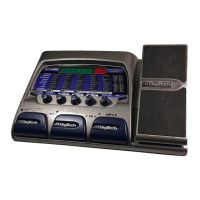
